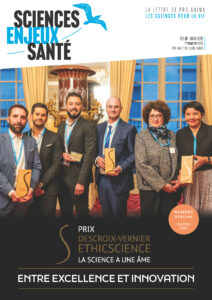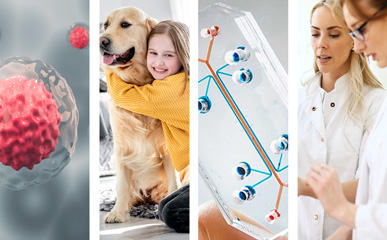
New NIH-funded center, Science & Innovation 7 new year tips by Fre-Sci, Green toxicology in Altex
News on non-animal methods
Jan 15-19, 20241. New NIH-funded center could soon reduce the need for pharmaceutical trials on animals
The University of Rochester will house a new national center focused on using tissue-on-chip technology to develop drugs more rapidly and reduce the need for animal trials. The National Institutes of Health awarded a $7.5 million grant to establish the Translational Center for Barrier Microphysiological Systems (TraCe-bMPS) at Rochester in partnership with Duke University.
The center aims to develop five Food and Drug Administration–qualified drug development tools related to study barrier functions in disease — interfaces in tissue that are critical for the progression of infection, cancer, and many autoimmune disorders. Over the five-year grant, the researchers will create drug development tools specifically related to central nervous system disorders, fibrosis, musculoskeletal autoimmune disease, sepsis, and osteomyelitis.
2. Bridging Science and Innovation in Organ-on-Chip and Organoids Development : 7 NEW YEARS TIPS by FRE-SCI
In the rapidly evolving field of scientific research, particularly in developing human-based models and methods like organ-on-chip or organoids or AI-based applications, there’s an emerging conversation that goes beyond the lab – the necessity of aligning scientific innovation with economic sustainability and end-users’ acceptance.
The Imperative of Market Viability/Economic sustainability
3. Altex : Alternative methods go green ! Green toxicology as a sustainable approach for assessing chemical safety and designing safer chemicals
Green toxicology is marching chemistry into the 21st century. This emerging framework will transform how chemical safety is evaluated by incorporating evaluation of the hazards, exposures, and risks associated with chemicals into early product development in a way that minimizes adverse impacts on human and environmental health. The goal is to minimize toxic threats across entire supply chains through smarter designs and policies. Traditional animal testing methods are replaced by faster, cutting-edge innovations like organs-on-chips and artificial intelligence predictive models that are also more cost-effective.
Core principles of green toxicology include utilizing alternative test methods, applying the precautionary principle, considering lifetime impacts, and emphasizing risk prevention over reaction.
Overall, the integration of green chemistry and toxicology has potential to profoundly shift how chemical risks are evaluated and managed to achieve safety goals in a more ethical, ecologically-conscious manner.
Altex celebrates its 40th anniversary in 2024, see ALTEX 2024 first issue
4. The “Big Three” in biocompatibility testing of medical devices : implementation of alternatives to animal experimentation — are we there yet ?
Biocompatibility testing ensures the safety of medical devices by assessing their compatibility with biological systems and their potential to cause harm or adverse reactions. Thus, it is a critical part of the overall safety evaluation process for medical devices. Three primary types of biocompatibility tests — cytotoxicity, irritation, and sensitisation assessment — are standard for nearly all medical devices. However, additional biocompatibility tests, such as genotoxicity, systemic toxicity, hemocompatibility, and implantation studies, may also be necessary, depending on the device’s nature and intended use.
While challenges persist in adopting these innovative methods, the trend towards embracing alternatives remains robust. This trend is driven by technological advancements, ethical considerations, and growing industrial interest and support, all collectively contributing to advancing safer and more effective medical devices.
5. Development of Human-Derived Photocrosslinkable Gelatin Hydrogels for Tissue Engineering
Hydrogels are often used as biomimetic matrices for tissue regeneration. The source of the hydrogel is of utmost importance, as it affects the physicochemical characteristics and must be carefully selected to stimulate specific cell behaviors. Naturally derived polymeric biomaterials have inherent biological moieties, such as cell binding and protease cleavage sites, and thus can provide a suitable microenvironment for cells. Human-derived matrices can mitigate potential risks associated with the immune response and disease transmission from animal-derived biomaterials.
In this article, the authors developed glycidyl methacrylate-modified human-derived gelatin (hGelGMA) hydrogels for use in tissue engineering applications.
6. Immunocompetent PDMS-Free Organ-on-Chip Model of Cervical Cancer Integrating Patient-Specific Cervical Fibroblasts and Neutrophils
Despite preventive measures and available treatments, cervical cancer still ranks as the fourth most prevalent cancer among women worldwide and remains the leading cause of cancer death in women in many developing countries.
To gain further insights into pathogenesis and to develop novel (immuno)therapies, more sophisticated human models recreating patient heterogeneities and including aspects of the tumor microenvironment are urgently required. A novel polydimethylsiloxane-free (PDMS-free) microfluidic platform, designed specifically for the generation and cultivation of cervical cancerous tissue, is introduced.
By utilizing thermoplastic materials instead of the commonly used PDMS, they circumvent challenges arising from strong absorption of small hydrophobic molecules ; an aspect that is particularly important for women’s health-related cancer models, where a controlled exposure to hormones and drugs that are often strongly hydrophobic could be required in future applications.
7. First brain organoids grown from fetal tissue offer window on development
At birth, a human baby’s brain contains the most neurons it will ever have. How this complex brain develops in the womb has been hard to study in humans. But a new and potentially controversial method, growing tiny, brainlike structures called organoids in a dish from human fetal brain tissue, could provide a realistic model and improve the study of developmental disorders or brain cancers.
The team that achieved this first, reported yesterday in Cell, has also shown it can genetically engineer the blobs of tissue, which could help the fetal brain organoids (FeBOs) mimic certain diseases.
8. EMA Consultation : Concept paper on the revision of the guideline on the principles of regulatory acceptance of 3Rs (replacement, reduction, refinement) testing approaches
Submission of comments on the Concept paper on the revision of the Guideline on the principles of regulatory acceptance of 3Rs (replacement, reduction, refinement) testing approaches is open until Feb, 28.
This Guideline was adopted in 2016 with the aim to encourage stakeholders and authorities to initiate, support and accept development and use of 3Rs testing approaches to replace, reduce and refine in vivo animal studies for human and veterinary medicinal products
Since its implementation, scientific, technological and regulatory knowledge on 3R testing approaches, such as microphysiological systems, including organ-on-chip models, has significantly evolved. Consequently, there is a need for more specific guidance to assist in the development and potential regulatory use of these New Approach Methodologies.


